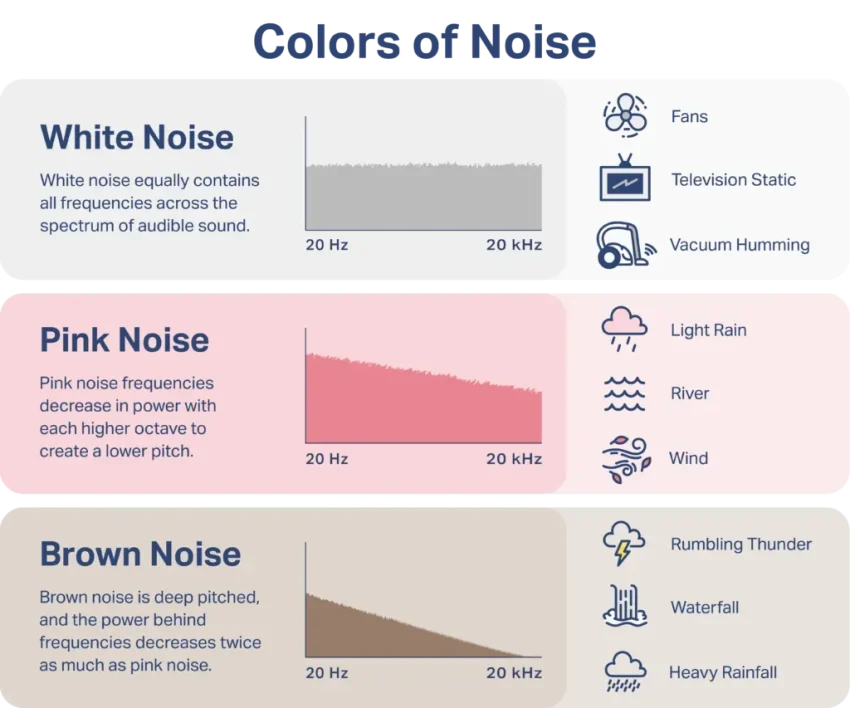Noise Effect on Sleep: How It Impacts Your Sleep Quality
The noise effect on sleep has become a growing concern for many individuals striving for optimal sleep quality. Recent studies indicate that even minimal bedroom noise can disrupt various sleep stages, particularly REM and deep sleep, leading to a decline in overall restorative sleep. Such disturbances not only shorten sleep duration but may also trigger physiological responses, including changes in heart rate variability. As we delve deeper into the research, it becomes evident that maintaining a quiet sleep environment is crucial for fostering uninterrupted slumber and promoting better health. By understanding the relationship between noise levels and sleep, we can take actionable steps towards improving our nightly rest and well-being.
When considering how sound impacts our nightly rest, we find that ambient noise can significantly influence various metrics of sleep health. The interplay between disturbed sleep patterns and environmental sounds challenges our ability to achieve restorative sleep, encompassing critical stages such as REM and deep sleep. Factors like bedroom acoustics not only affect how long we sleep but also our physiological responses, including variations in heart rate and sleep architecture. Emphasizing a serene sleeping environment may enhance one’s overall sleep experience, helping to mitigate the adverse effects linked to poor sleep quality. As such, exploring noise’s role in our sleep behavior is vital for anyone looking to improve their nightly rest.
Understanding the Impact of Bedroom Noise on Sleep Quality
Bedroom noise plays a significant role in determining sleep quality. Scientific research indicates that consistent exposure to noise during the night can lead to disturbances in sleep patterns, particularly affecting the important phases of REM and deep sleep. For instance, studies have shown that even moderate noise levels, typically around 55 dB, can lead to reduced REM sleep duration, which is essential for cognitive function and emotional regulation. When noise levels exceed 60 dB, the effects worsen, resulting in significant drops in both deep sleep and overall sleep duration.
This impact on sleep quality is not merely anecdotal; it is substantiated by empirical data gleaned from sleep tracking devices like the Apple Watch. These devices measure various metrics, including heart rate variability and overall sleep stages, providing insight into how noise disrupts our natural sleep architecture. Observations indicate a distinct threshold effect around the 60 dB mark, where sleep quality deteriorates sharply. Thus, maintaining a quiet bedroom environment is crucial for achieving restorative sleep, enhancing both mental and physical health.
The Mechanism: Noise and Its Effects on REM Sleep
REM sleep is particularly sensitive to disturbances. It is during this stage of sleep that most dreaming occurs and where significant brain activity takes place, crucial for memory consolidation and emotional processing. The noise effect on sleep is profound, as increased ambient noise—beyond 55 dB—has been shown to directly reduce the time spent in REM sleep. This reduction can have cascading effects on a person’s mood and cognitive capabilities, as inadequate REM sleep leads to impairments in both memory and emotional stability.
Furthermore, research indicates that as noise levels climb further into the 60 dB range, not only does REM sleep length decrease, but the quality of sleep deteriorates overall. Individuals may experience more frequent awakenings and lighter sleep stages, thereby preventing them from reaching the deeper levels of sleep essential for physical restoration. It’s critical for individuals to understand this relationship between noise and REM sleep, as minimizing bedroom noise could effectively enhance sleep quality and overall health.
The Relationship Between Heart Rate Variability and Sleep Disturbances
Heart Rate Variability (HRV) serves as an important physiological marker of sleep quality, with its levels indicating how well the body manages stress during the night. Studies have demonstrated that noise exposure during sleep can lead to a significant drop in HRV, reflecting underlying stress responses that compromise sleep quality. When ambient noise levels cross the pivotal 60 dB mark, HRV decreases by 15-20%, signaling that the body is under increased stress, which can inhibit the natural restorative processes that occur during peaceful sleep.
The connection between heart rate variability and sleep disturbances underscores the broader implications of how noise affects not just sleep architecture, but overall health. Effective sleep, characterized by higher HRV, often correlates with better heart health, reduced anxiety, and improved cognitive function. Maintaining a tranquil sleeping environment is therefore essential, as it not only promotes restful sleep but also aids in the maintenance of healthy cardiovascular function.
Exploring the Threshold Effect of Noise on Sleep Patterns
The concept of a threshold effect in relation to noise and sleep is compelling. Research findings highlight that below certain decibel levels, such as the low-50s dB range, minor reductions in noise can yield notable improvements in sleep quality. However, once noise levels rise beyond the crucial threshold of approximately 60 dB, the adverse effects on REM sleep, deep sleep, and total sleep duration become increasingly pronounced and detrimental. This phenomenon indicates a need for effective measures to create quieter sleeping environments.
Understanding the threshold effect of noise on sleep is vital for developing effective sleep hygiene practices. Simple adjustments, such as utilizing soundproofing elements in the bedroom or employing white noise machines, can help lower ambient noise levels to promote better sleep outcomes. This awareness empowers individuals to take actionable steps toward enhancing sleep quality, with long-term implications for their overall health and well-being.
Strategies for Minimizing Noise and Improving Sleep Quality
Implementing strategies to minimize noise in the bedroom can significantly enhance sleep quality. Techniques such as installing soundproof curtains, using earplugs, and ensuring that windows and doors are well-sealed can effectively reduce incoming noise. Additionally, creating a soothing bedroom ambiance with soft textures and calming colors can further encourage a peaceful environment conducive to sleep. Incorporating white noise machines can also mask disruptive sounds, providing a consistent auditory background that may improve the ability to fall and stay asleep.
It’s also beneficial to evaluate and adjust lifestyle choices that might contribute to noise. For example, monitoring the use of electronics and devices that can create background noise, such as televisions and computers, can make a big difference. Moreover, establishing a nightly routine that promotes relaxation before bedtime, such as reading or meditating, can help signal the body that it is time to prepare for sleep, further counteracting the disruptive effects of noise and enhancing overall sleep health.
The Role of Sleep Duration in Overall Well-Being
Sleep duration is a fundamental component of sleep quality, directly influencing physical health and mental well-being. The average adult requires about 7 to 9 hours of sleep each night for optimal functioning. However, excessive bedroom noise can significantly reduce sleep duration, as demonstrated by empirical studies linking increased noise levels to shortened sleep times. When noise exceeds the comfort threshold, individuals may spend less time in restorative sleep stages, particularly REM and deep sleep, where bodily recovery occurs.
Prolonged reductions in sleep duration can lead to chronic sleep deprivation, associated with a multitude of negative health outcomes, including obesity, diabetes, and cardiovascular disease. Thus, optimizing sleep duration should be a priority, and minimizing bedroom noise is integral to achieving this goal. By fostering an environment that supports longer sleep durations, individuals can enhance their overall health and prevent sleep-related issues from arising.
Adapting to a Noisy Environment: Tips for Better Sleep
Adapting to a noisy environment necessitates practical techniques to improve sleep quality. Firstly, effective use of heavy curtains, carpets, or rugs can absorb sound and create a sound barrier, minimizing disturbances during the night. Additionally, individuals may find relief through mindfulness or relaxation exercises before bedtime, which can help mitigate the stress that noise may induce, enabling them to fall asleep more quickly despite external disturbances.
In environments that remain noisily constant, such as city living, many people have successfully leveraged technologies, such as white noise machines or sleep apps, which can generate soothing sounds that mask unpleasant noise. These methods allow individuals to drown out disruptive sounds from their surroundings effectively. Emphasizing these techniques allows for a proactive approach to sleep hygiene, helping individuals maintain sound sleep despite less-than-ideal auditory conditions.
The Long-term Consequences of Poor Sleep Quality
Long-term exposure to poor sleep quality can have severe implications for both mental and physical health. Chronic disturbances in sleep can contribute to issues like anxiety, depression, and a weakened immune system. Studies have linked consistent lack of REM and deep sleep due to bedroom noise to cognitive decline and increased risk of chronic diseases. It is essential to recognize that sleep is not merely a restorative process but a crucial element that sustains overall vitality and function.
By prioritizing noise reduction and optimizing sleep quality, individuals can help mitigate these long-term health risks. Acknowledging the relationship between sleep disturbances, such as those caused by noise, and various health outcomes emphasizes the importance of combatting external factors that can inhibit restful sleep. Creating a healthier sleep environment is a crucial investment in one’s holistic health journey.
Embracing Sleep Health: A Necessity for Modern Living
In an era where productivity often comes at the expense of sleep, prioritizing sleep health has never been more critical. Noise pollution has surfaced as a prevalent issue impacting sleep quality globally, with serious repercussions for physical and mental well-being. As we strive for optimal health, embracing the concept of sleep health means acknowledging that our environments play a direct role in our ability to achieve restful and restorative sleep.
Encouraging a shift in the cultural mindset surrounding sleep can facilitate broader discussions on effective strategies for improving sleep hygiene amidst modern lifestyle challenges. By promoting awareness of how noise affects sleep quality, individuals can take meaningful steps toward creating sleep-conducive environments that support better health and overall quality of life. Empowering ourselves and those around us with knowledge about sleep health can substantially impact our physical and emotional resilience in today’s fast-paced world.
Frequently Asked Questions
How does bedroom noise affect sleep quality?
Bedroom noise significantly impacts sleep quality, leading to disruptions in REM sleep and deep sleep stages. Studies show that as noise levels exceed 55 dB, REM sleep decreases substantially, with further declines as noise reaches 60 dB, impacting overall sleep duration and quality.
What noise levels are harmful to REM sleep?
Research indicates that REM sleep begins to decline sharply once bedroom noise levels surpass 60 dB, similar to the sound of normal conversation. Keeping noise below this level is essential for preserving REM sleep and thereby enhancing sleep quality.
Can bedroom noise impact deep sleep?
Yes, high levels of bedroom noise adversely impact deep sleep. As noise levels rise above 50 dB, deep sleep duration decreases significantly, with noticeable drops occurring when noise hits around 60 dB. Maintaining a quiet sleep environment is crucial for optimizing deep sleep.
What is the relationship between heart rate variability and sleep noise?
Heart rate variability (HRV) is negatively affected by increased noise levels during sleep. As bedroom noise rises beyond 60 dB, HRV declines sharply, indicating a higher overnight stress load that disrupts sleep architecture and overall sleep health.
How can noise levels impact total sleep duration?
Total sleep duration is closely related to noise levels. When noise remains below 55 dB, individuals may achieve around 6¼ to 6½ hours of sleep, but durations can shrink by nearly an hour once noise exceeds 60 dB, primarily affecting REM and deep sleep.
What is the threshold effect of noise on sleep?
The threshold effect of noise on sleep occurs around 60 dB. Below this level, incremental reductions in noise lead to improved sleep quality, but exceeding this threshold results in rapid declines in sleep metrics, including REM and deep sleep, as well as increased heart rate.
What strategies can improve sleep quality in noisy environments?
To improve sleep quality in noisy environments, consider using white noise machines, earplugs, or soundproofing your bedroom. Additionally, keeping noise levels below 60 dB can help maintain restorative sleep stages and improve overall sleep health.
How does noise during sleep affect physiological responses?
Noise during sleep influences physiological responses, resulting in increased heart rate and decreased heart rate variability. These changes suggest that noise disrupts the body’s ability to maintain a calm physiological state, which is crucial for restorative sleep.
What role does sleep tracking play in assessing noise impact on sleep?
Sleep tracking devices, such as the Apple Watch, can monitor sleep metrics, including duration and stages, as well as environmental noise levels. This data helps individuals understand how bedroom noise affects their sleep quality and make informed adjustments for better sleep.
Why is it important to reduce bedroom noise for sleep health?
Reducing bedroom noise is vital for sleep health as it promotes better sleep quality by preserving REM and deep sleep stages. Keeping noise levels below the critical threshold of 60 dB helps maintain physiological calm and enhances overall sleep duration.
| Metric | Findings |
|---|---|
| Noise Levels ( | Allows for better sleep quality and duration, maintaining high REM and deep sleep levels. |
| Noise Levels (55-60 dB) | Moderate impact, with slight reductions in REM and deep sleep. |
| Noise Levels (>60 dB) | Significant decrease in sleep quality, with REM and deep sleep reduced by a quarter and total sleep duration shortened by up to an hour. |
| Heart Rate (HR) | Stable below 50 dB, increases by 4-5 bpm when noise exceeds 60 dB. |
| Heart Rate Variability (HRV) | Minor dips below 50 dB with a significant drop of 15-20% at ~60 dB, indicating increased stress levels. |
| Empirical Health Sleep Score | High scores (70s) below 55 dB drop into the 60s once noise goes above 60 dB, indicating poor overall sleep quality. |
Summary
The noise effect on sleep is significant and should not be underestimated. Research indicates that bedroom noise disrupts sleep quality in a dose-dependent manner, particularly when sound levels exceed 60 dB. Below this threshold, individuals can maintain healthier sleep stages, including REM and deep sleep. However, with increasing noise, not only does total sleep time decrease, but physiological responses like heart rate and heart rate variability also indicate increased stress. This highlights the importance of managing noise levels in sleeping environments to ensure restorative sleep.
#SleepHealth #NoisePollution #SleepQuality #WellnessScience #HealthySleepHabits








